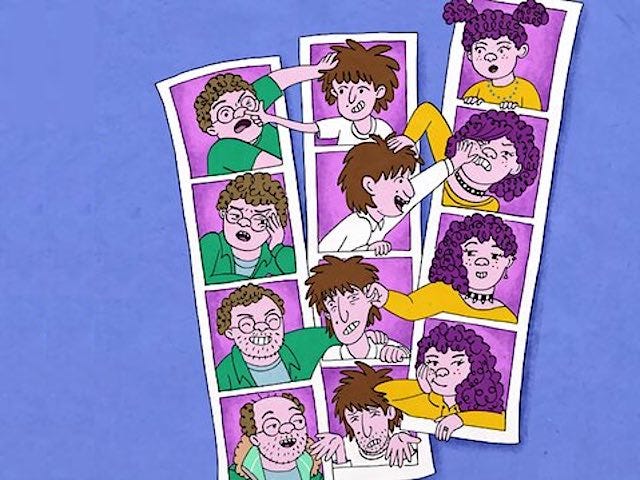The Incomplete Guide to Itch.io and Long Story Short
In which Vanessa explores the indie gaming phenomenon and Elliot travels back and forth in time with the animated Schwooper family
The free wonders of itch.io
By Vanessa Burke
In an era where AAA studios chase the latest graphical fidelity and billion-dollar budgets, some of the most compelling gaming experiences are quietly emerging from the indie corners of itch.io. “Type Help”, a cryptic puzzle game by William Rous published at the start of this year, exemplifies this perfectly – a deceptively simple interface hiding layers of complexity that can consume days of dedicated detective work.
“Type Help” presents itself as "old transcripts from a cold case" where players must "prevent further incidents". What seems like a straightforward text-based mystery quickly evolves into something far more intricate. Last weekend, I found myself constructing elaborate spreadsheets, cross-referencing cryptic codes, and diving deep into constructing the disastrous timeline.
This phenomenon isn't isolated. We're witnessing an intriguing trend where successful free games are being given professional remasters while their original versions remain freely available. The most prominent example is “The Roottrees are Dead”, originally created for Global Game Jam 2023 and released as a free browser game, which later received a full Steam remaster with hand-drawn illustrations, enhanced UI, and remastered audio to replace AI and improve the puzzle. The original made $2,000-$3,000 from over 10,000 players through donations alone, proving there's genuine appetite for these experiences.
This dual-release strategy represents something revolutionary in gaming economics. Traditional publishers typically gate their content behind paywalls, but this new approach creates a compelling funnel: the free version serves as an extended demo that hooks players, while the premium version offers genuine improvements for those willing to pay. The Steam version of “The Roottrees are Dead” isn't just a port – it lifts the game from its browser-based confines into a virtual space that’s been crafted with more resources.
For developers, this model offers multiple advantages. The free version builds community, generates word-of-mouth marketing, and serves as proof-of-concept for investors or collaborators interested in funding a professional version. Players benefit from immediate access to the core experience while having the option to upgrade for enhanced features. It's a win-win that respects both the creator's need for revenue and the community's desire for accessibility.
The success of games like “Type Help” and “The Roottrees are Dead” also highlights changing player preferences. In an oversaturated market, players are increasingly drawn to unique, memorable experiences over formulaic productions. These games succeed not through marketing budgets or flashy trailers, but through genuine innovation and community engagement. When players are building their own spreadsheets to solve your puzzles, you've created something special.
This trend may well represent the future of indie game development. Rather than betting everything on a single commercial release, developers can build communities around free versions, then reinvest community feedback and success into professional productions. It's a sustainable model that allows for creative risk-taking while providing financial pathways for successful projects.
The gaming industry has long struggled with the tension between accessibility and profitability. Free-to-play models often rely on manipulative monetization, while premium games exclude players who can't afford them. The remaster approach offers a third path: genuine value proposition where free players get complete experiences and paying customers get meaningful enhancements.
As we look toward the future of gaming, perhaps the most innovative studios won't be those with the biggest budgets, but those who understand that building communities around compelling free experiences can create sustainable pathways to professional success. In a world where players spend days constructing spreadsheets to solve indie puzzles, there's clearly hunger for experiences that respect intelligence and reward dedication – whether they cost nothing or everything.
An Incomplete Guide to Long Story Short
By Elliot Wengler
I often argue with my family that we should cancel Netflix, as it has no shows apart from Stranger Things. They then inform me that it has something called Bridgerton, and now and then I do return to it to click on a movie because its user interface is a billion times better than Prime’s, and Disney+ just doesn’t have any cosy sitcoms or bolshy animations on par with Big Mouth (I love Solar Opposites, but it requires a lot of energy). Big Mouth has also now ended, so the animated show that I had the most investment in did make me consider ending my Netflix consumption again.
Then, in need of a cosy show with a bit of wit that was actually new, I remembered that Raphael Bob-Wakesberg’s new animation, Long Story Short, arrived whilst I was away. It’s one of those rare shows that I could not put down, and have already started it again. After Bob-Wakesberg’s seminal work, BoJack Horseman, ended back in 2020 (something that I am ashamed to admit that I only started watching in lockdown), his immediate follow-up, Tuca and Bertie, didn’t prove to have quite the staying power.
Long Story Short, unlike BoJack Horseman and Tuca and Bertie, is all about human beings rather than animals living lives like ours. This alone probably removes barriers to entry and also allows us, as the title suggests, to get straight to the point. Long Story Short is somewhere between an anthology and a biography in terms of its storytelling about the Schwooper family. Naomi Schwartz and Elliot Cooper (Lisa Edelstein and Paul Reiser) are the parents, and Avi (Ben Feldman), Shira (Abbi Jacobson), and Yoshi (Max Greenfield) the 3 children. The opening depicts the family travelling between a funeral and a wake, with teenage Avi and Shira and kid Yoshi, then immediately cuts forward 11 years to 2004.
That’s the show’s first gimmick: the entire thing is non-linear, and not in a How I Met Your Mother sense of using different timings in a week for the A and B plot. Episode 1 is Yoshi’s bar mitzvah in 2004, 2 is Avi’s child’s winter-mas pageant in 2014, 3 in 2013, four in 2021, and so on. It’s odd to say “and so on” because you genuinely don’t know when the next episode’s story will be, and incredibly, it never feels inaccessible. As we’re shown the different developments in the Schwooper’s lives out of sequence, topical references anchor us to news and world affairs, and we see relationships begin and divorces reverberate, with the pieces of the puzzle of how it happened given to us later.
This makes it sound like the show is dour and lacking humour. It is laugh-out-loud funny all the way through because all of the characters feel real, despite the pastel animation. It’s witty to listen to, and beautiful to look at. I’m not sure I’ve ever seen animation like this before; it feels like a children’s pop-up book whilst examining such human characters and the scary world they navigate: reality.
Short Stories Long
The show’s central arc covers the challenging relationship Avi and Shira have with their overbearing and intense mother, who in turn just wants the best for her family, no matter how unable she is to accept that her best isn’t best for everyone else. At points in the show Naomi is utterly intolerable, but always understandable and empathetic. Everyone is steamrolled by her, everyone is frustrated by her - at times, the kids downright hate her - but weirdly enough, as much as I dreaded what she was going to impose on her family next, I never found myself disliking her. She’s honest, and flawed. We all know overbearing people like this.
Throughout the show, Avi’s girlfriend and eventual wife, Jenn (Angelique Carbral), and Shira’s girlfriend, Kendra (Nicole Byer), appear, and Kendra in particular gets equal development to the family. Everyone has serious flaws to work on, and lies their way through life, and seeks each other’s forgiveness. We eventually see Avi’s and Shira’s respective experiences and pressures of parenting, and it feels like we’ve known these characters our whole lives.
I am not Jewish, so it’s not for me to say how truly the show speaks to the ‘Jewish experience’, but clearly it laughs at the traditions and ways of Judaism and its many forms with love. Much like in BoJack Horseman, there’s a lot of reflecting on how childhood informs adulthood, and a lot like BoJack, this show clearly has a long life ahead of it. I’m already considering a rewatch and shuffling the episodes to chronological order. Or would that not be in the spirit of Long Story Short?
Did you watch Long Story Short? Did you find it informative, adorable, intense, loveable and very very funny? Let us know in the comments below!




